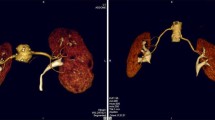Abstract
The aims of this study were (1) to assess the diagnostic performance of multidetector row computed tomography angiography (CTA) on imaging of renal artery branches and (2) to investigate the effect of different iodine concentrations at constant total iodine load and either constant injection rates or constant iodine administration rates. A number of 120 consecutive patients (71±6 years of age) underwent CTA of renal arteries (collimation 4×1 mm) using the nonionic contrast medium iopromide, and were divided into six equal groups: 1: 150 ml, 240 mg/ml at 4 ml/s; 2: 120 ml, 300 mg/ml at 4 ml/s; 3: 97.3 ml, 370 mg/ml at 4 ml/s; 4: 150 ml, 240 mg/ml at 5 ml/s; 5: 120 ml, 300 mg/ml, 60 ml at 6 ml/s, 60 ml at 3 ml/s; 6: 97.3 ml, 370 mg/ml at 3.3 ml/s. The image quality of the main renal arteries (n=240) and their first-order to fourth-order branches was scored as 0 for no visualization, 1 for only visualization, and 2 for diagnostic. All main renal arteries were diagnostic. First-order branches had score 2 in 38/40, 40/40, 37/40, 38/40, 39/40, and 40/40 patients for groups 1–6, respectively (p=0.34). Second-order branches were imaged best in group 2 (p<0.002)). Third-order branches had score 2 in only 1/40, 5/40, 1/40, 2/40, 0/40, and 2/40 renal arteries. Fourth-order branches were not imaged diagnostically. At a constant total iodine load, the main renal arteries and their first-order branches achieved diagnostic image quality at all iodine concentrations in four-channel multidetector row CTA for the protocols tested. Second-order renal artery branches were imaged best at 120 ml contrast medium with an iodine concentration of 300 mg/ml at 4 ml/s.

Similar content being viewed by others
References
Urban BA, Ratner LE, Fishman EK (2001) Three-dimensional volume-rendered CT angiography of the renal arteries and veins: normal anatomy, variants, and clinical applications. Radiographics 21 373–386
Wittenberg G, Kenn W, Tschammler A, Sandstede J, Hahn D (1999) Spiral CT angiography of renal arteries: comparison with angiography. Eur Radiol 9:546–551
Beregi JP, Elkohen M, Deklunder G, Artaud D, Coullet JM, Wattinne L (1996) Helical CT angiography compared with arteriography in the detection of renal artery stenosis. Am J Roentgenol 167 495–501
Kim TS, Chung JW, Park JH, Kim SH, Yeon KM, Han MC (1998) Renal artery evaluation: comparison of spiral CT angiography to intra-arterial DSA. J Vasc Interv Radiol 9:553–559
Galanski M, Prokop M, Chavan A, Schaefer CM, Jandeleit K Nischelsky JE (1993) Renal arterial stenoses: spiral CT angiography. Radiology 189:185–192
Galanski M, Prokop M, Chavan A, Schaefer C, Jandeleit K, Olbricht C (1994) Accuracy of CT angiography in the diagnosis of renal artery stenosis. Fortschr Röntgenstr 161:519–525
Hahn U, Konig CW, Miller S, Brehm B, Heuschmid M, Kopp AF, Claussen CD (2001) Multidetector CT angiography—is it a valuable screening tool to detect significant renal artery stenosis? Fortschr Röntgenstr 173:1086–1092
Willmann JK, Wildermuth S, Pfammatter T, Roos JE, Seifert B, Hilfiker PR, Marincek B, Weishaupt D (2003) Aortoiliac and renal arteries: prospective intraindividual comparison of contrast-enhanced three-dimensional MR angiography and multi-detector row CT angiography. Radiology 226:798–811
Pohl MA, Novick AC (1985) Natural history of atherosclerotic and fibrous renal artery disease: clinical implications. Am J Kidney Dis 5:A120–A130
Fain SB, King BF, Breen JF, Kruger DG, Riederer SJ (2001) High-spatial-resolution contrast-enhanced MR angiography of the renal arteries: a prospective comparison with digital subtraction angiography. Radiology 218:481–490
Kopp AF (2003) Angio-CT: heart and coronary arteries. Eur J Radiol 45:S32–S36
Sandstede JJ, Tschammler A, Beer M, Vogelsang C, Wittenberg G, Hahn D (2001) Optimization of automatic bolus tracking for timing of the arterial phase of helical liver CT. Eur Radiol 11:1396–1400
Becker CR, Hong C, Knez A, Leber A, Bruening R, Schoepf UJ, Reiser MF (2003) Optimal contrast application for cardiac 4-detector-row computed tomography. Invest Radiol 38:690–694
Fleischmann D (2003) MDCT of renal and mesenteric vessels. Eur Radiol 13:M94–M101
Fleischmann D (2003) Use of high-concentration contrast media in multiple-detector-row CT: principles and rationale. Eur Radiol 13:M14–M20
Knollmann F, Schimpf K, Felix R (2004) Iodine delivery rate of different concentrations of iodine-containing contrast agents with rapid injection. Fortschr Röntgenstr 176:880–884
Author information
Authors and Affiliations
Corresponding author
Rights and permissions
About this article
Cite this article
Sandstede, J.J.W., Kaupert, C., Roth, A. et al. Comparison of different iodine concentrations for multidetector row computed tomography angiography of segmental renal arteries. Eur Radiol 15, 1211–1214 (2005). https://doi.org/10.1007/s00330-005-2677-1
Received:
Revised:
Accepted:
Published:
Issue Date:
DOI: https://doi.org/10.1007/s00330-005-2677-1




